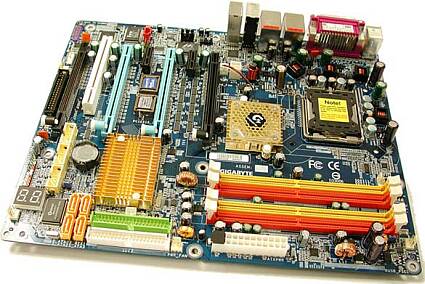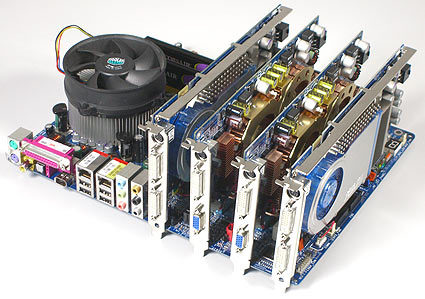One Gigabyte Motherboard, Four Graphics Cards
Gigabyte Goes Crazy With Quad Graphics SLI Motherboard
Gigabyte's idea of building a motherboard that would support as many as four PCI Express graphics cards is not quite new. In fact, we were asked for our opinion on such a product as early as May, when we spent some time in Taipei, Taiwan for Computex. Okay, it was four PCIe slots then. But even before knowing any technical details, we were already quite confident that the realization of this project actually was not far away.
Gigabyte has proven to be accelerating the pace of development when it comes to technically sophisticated hardware. They have released products such as a Pentium 4 motherboard with PCI-X support , a dual graphics motherboard capable of supporting SLI yet based on an Intel chipset, and of course its popular 3D1 graphics cards family that currently supports either two 6600 GT or 6800 GT chips on a single graphics board. Although this does not particularly help to reduce the total costs for a SLI solution, it definitely is the nicer solution.
Gigabyte's latest stroke of genius is the GA-8N SLI Quad Royal, and is a very high-end motherboard that powers an Intel socket 775 Pentium 4, Pentium D or Pentium Extreme Edition processor via an NVIDIA nForce4 SLI Intel Edition chipset. NVIDIA chose HyperTransport to link the north bridge and south bridge components of the Intel Edition chipset. Gigabyte saw an opportunity to drop the south bridge (called the MCP or Media Communications Processor) in favor of an nForce4 SLI chipset - the AMD version!
All of this was possible because the nForce4 SLI for Athlon 64 is a single-chip solution and incorporates all the interfaces such as storage, networking, and USB that are essential for modern core logic products. After hooking up both chips via HyperTransport, Gigabyte not only had access to the nForce4 AMD Edition's interface features, but also found itself in a position to implement four x8 PCIe slots or two x16 slots.
In theory, this solution would even be capable of running either an AMD Athlon 64 or Intel's Pentium family, since both core logic components are completely available. However, this dual implementation is something that might just be too much of an effort to carry out. The problems start with fairly complex routing and the need for a more flexible clock generator - or a way of switching between two of them. In addition, this would lead to motherboard size issues due to the additional socket and voltage regulators, greatly increasing product costs. Though this would be the coolest thing since the invention of memory modules, it ultimately wouldn't be worthwhile.
Okay, let's come back from dreamland and take a look at what is worthwhile - Gigabyte's GA-8N SLI Quad Royal.
Get Tom's Hardware's best news and in-depth reviews, straight to your inbox.
Current page: Gigabyte Goes Crazy With Quad Graphics SLI Motherboard
Next Page Gigabyte GA-8N SLI Quad Royal
Patrick Schmid was the editor-in-chief for Tom's Hardware from 2005 to 2006. He wrote numerous articles on a wide range of hardware topics, including storage, CPUs, and system builds.
-
ShrikeC145 That looks absolutely amazing! Just wondering, what model of graphics cards are they?Reply -
jealousfraud Three ways to Setup Multiple MonitorsReply
1) You can buy a pre-manufactured multi-monitor computer. The best place to purchase a multiple monitor computer is at: Multi-Monitors.com. They carry a multi-monitor computer line called SUPER-PC that can support from 2 to 16 monitors.
Multi-Screen Computer Systems
Multiple Monitor LCD Displays
2) You can get a USB to VGA Adapter, or USB to DVI Adapter that will allow you to add an extra monitor to your computer via any USB2.0 Port. You can also add multiple extra monitors by using multiple adapters. This is a great option for viewing documents, surfing the web, using Microsoft Office and many other business tasks. This is not a good option for intense graphical situations such as HDTV, Blu-ray, Gaming and 3D / CAD Workstation applications. For those types of scenarios, it is highly recommended that you purchase a high-powered multi-monitor workstation or a Matrox Dual or Triple Head2Go.
Multi-Monitor Adapters
3) You can replace or add an extra video card to your existing computer, depending on how many monitors you wish to support. Although this sounds easy enough, this is a rather complex solution for a beginner, especially when trying to find a compatible graphics card. For this reason, I am going to write an entirely seperate post on that topic and will link to it here, very soon.
Multi-Monitor Video Cards
Once you have your multiple monitor system set up and ready to use, you will need to enable all of your monitors in your “Display Properties” Control Panel. Here is a great link to a complete and animated walkthrough of how to enable your multiple monitors in Windows.
How to Setup Multiple Monitors (Instructions)
This is what it will look like when you are done:
Multi-Monitor Video Demo 1Multi-Monitor Video Demo 2

